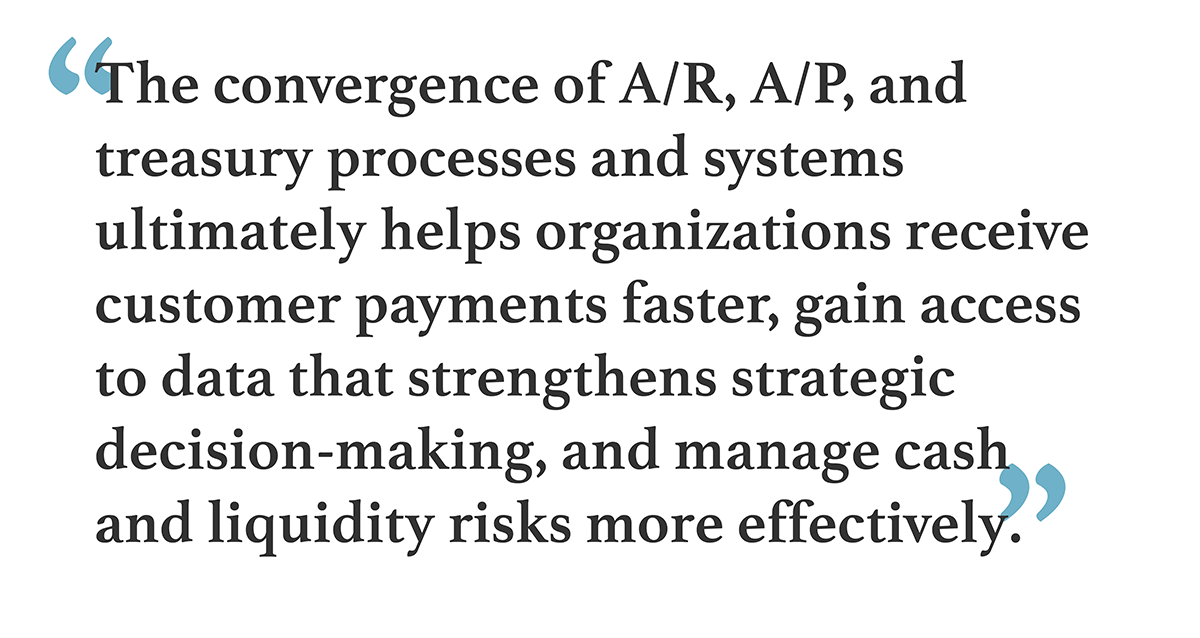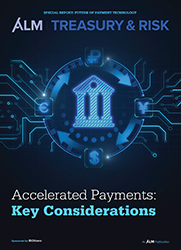
The brief but steep Covid recession in the spring of 2020 turbocharged companies' efforts to improve accounts receivable (A/R) efficiency to stave off working capital and liquidity management problems. These efforts mainly focused on automating manual processes and improving traditional key performance indicators (KPIs) such as days sales outstanding (DSO), past-due invoices, and average days delinquent (ADD).
At the same time, many businesses also tackled accounts payable (A/P) improvement initiatives, which typically focused on days payables outstanding (DPO), payment error rates, and per-invoice processing costs, among other accuracy and efficiency KPIs.
While these metrics remain crucial, new payment technologies and integrations offer additional opportunities to notch substantial A/R and A/P efficiency improvements. The convergence of receivables and payables activities with corporate treasury processes and technology systems deserves special attention.
When asked the extent to which treasury functions are leveraging new technologies to improve receivables and payables, Ernst & Young LLP partner/principal Kasif Wadiwala rattles off numerous examples: Banks are upgrading their systems to reduce friction in the processes on both sides of business-to-business (B2B) transactions. Systems that simplify early-pay discounts are helping companies address cash-flow constraints. And Wadiwala points to one bank's implementation of corporate treasury application programming interfaces (APIs) that "enable treasurers to initiate, track, and complete transactions from directly within their various platforms."
Prashant Patri, a Deloitte Risk & Financial Advisory principal, observes that many incumbent payment-technology vendors have invested substantial time, money, and creativity in fostering greater end-to-end platform connectivity. This can enable treasury functions and their finance and accounting colleagues to improve accounts receivable and accounts payable processes, Patri says. "For example, treasurers can use payment hubs from [treasury management system] vendors to consolidate A/P payments and create fewer exit points for cash. In doing so, they are able to strengthen governance over cash and reduce payments-fraud risks."

Treasury and payments experts emphasize that accounts receivable, accounts payable, and treasury processes continue to converge. Patri attributes this trend to "platform blending," which is primarily driven by "[treasury management system] vendors investing in new capabilities or strengthening integrations between existing or new platforms."
Deeper collaborations between payments groups and treasury teams help drive systems' convergence. Wadiwala and Patri identify several beneficial outcomes of merging payment activities with treasury systems and processes, including those related to:
- The bottom line. Stronger partnerships between A/P and treasury groups can result in faster payments to suppliers and better optimization of early-pay discounts. "Convergence among treasury payments solutions is helping organizations gain greater visibility into end-to-end cash and liquidity balances across bank accounts and legal entities," Patri explains. This, in turn, helps enable better planning and forecasting for funding investment needs, optimizing borrowing costs, and (in some cases) boosting investment returns. "This is a critical benefit of convergence, given current financial market conditions—particularly rising interest rates," Patri emphasizes.
- Working capital management. "Treasury gets insight into valuable data," Wadiwala notes, while A/R and A/P enhance their contributions to the company's working capital.
- Risk management. Convergence gives treasury and A/P groups quicker access to more data and insights concerning compliance requirements, such as Know Your Customer (KYC) verifications.
The convergence of A/R, A/P, and treasury processes and systems ultimately helps organizations receive customer payments faster, gain access to data that strengthens strategic decision-making, and manage cash and liquidity risks more effectively. These benefits, Wadiwala concludes, help "improve operational efficiency."
See also:

- November 2022 Special Report
- Accelerated Payments: Key Considerations
- The Pros and Cons of New Digital Payment Options
- Payment Innovations on the Horizon
- Road Map out of the A/P Silo
- A Clear Path to A/P and A/R Automation
- A/P and A/R Netting Nets Benefits in the Millions
- How to Upgrade Your Accounts Receivable Strategy
- Genuine Transformation of Working Capital Management
Eric Krell's work has appeared previously in Treasury & Risk, as well as Consulting Magazine. He is based in Austin, Texas.
© 2025 ALM Global, LLC, All Rights Reserved. Request academic re-use from www.copyright.com. All other uses, submit a request to [email protected]. For more information visit Asset & Logo Licensing.





